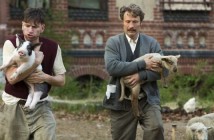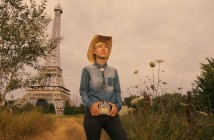Closer to the Moon (2013)
Cast: Vera Farmiga, Mark Strong, Harry Lloyd
Director: Nae Caranfil
Country: Romania | USA | Italy | Poland
Genre: Comedy | Drama
Official Trailer: Here
Editor’s Notes: The following review is apart of our coverage of the Transilvania International Film Festival. For more information visit http://tiff.ro/en and follow TIFF Romania on Twitter at @tiffromania.
The story told in Closer to the Moon is the sort lonely obnoxious people like to store away so they can have examples ready to prove their point that truth is stranger than fiction. In 1959 in Romania, five well educated Jews, former rising stars in that country’s communist party, robbed a bank van of a large sum of money - in broad daylight, with crowds watching as they pretended that they were shooting a film. Once caught, they were ordered by the government to recreate the raid for a propaganda film with anti-Zionist overtones. It is a strange tale, to be sure, and Closer to the Moon manages to capture some of that strangeness despite its paint by numbers approach to historical drama.
The most interesting structural feature of the film is its non-linear approach to time. Split into chapters, the film jumps back and forth between the creation of the film and the events prior, to gradually reveal the motives behind the robbery. This is not a new technique, of course, but it feels more at home in a crime film a la Tarantino than in a relatively straightforward historical drama. The gambit mostly works because it serves to deepen the characters, especially charismatic Max (Mark Strong), the leader of the expedition, and his lover Alice (Vera Farmiga). It also helps draw in Virgil (Harry Lloyd), the young camera man in charge of the film, who finds himself sympathizing more and more with the people he is supposed to vilify.
…the film takes few chances in its presentation of the events. It takes most of its cues from the giant playbook of important historical dramas.
 Aside from that central structure, the film takes few chances in its presentation of the events. It takes most of its cues from the giant playbook of important historical dramas. These characters actually existed, of course (the central ones, at least), but here they have been polished and shined to resemble the stock characters in a story about courage in the face of oppression. Aside from Max and Alice, the gang consists of a thoughtful physicist, a reluctant history professor (naturally he’s the chubby one), and a journalist who’s a loose cannon. There’s the bad guy who obsesses over a broader conspiracy, then the real bad guy behind him, the one who pulls the strings. Virgil of course plays the role of ingenue, inducted into a world his naive eyes cannot imagine. There’s even a drunk, regretful artist - in this case Virgil’s director mentor. Most cringe worthy of all is Virgil’s landlord, a worldly wise old Jewish man who seems to exist solely to underscore the film’s themes in red pen. To be fair, the old man is played with a mischievous sparkle by David de Keyser, but he still mostly functions as a heavy handed metaphor.
Aside from that central structure, the film takes few chances in its presentation of the events. It takes most of its cues from the giant playbook of important historical dramas. These characters actually existed, of course (the central ones, at least), but here they have been polished and shined to resemble the stock characters in a story about courage in the face of oppression. Aside from Max and Alice, the gang consists of a thoughtful physicist, a reluctant history professor (naturally he’s the chubby one), and a journalist who’s a loose cannon. There’s the bad guy who obsesses over a broader conspiracy, then the real bad guy behind him, the one who pulls the strings. Virgil of course plays the role of ingenue, inducted into a world his naive eyes cannot imagine. There’s even a drunk, regretful artist - in this case Virgil’s director mentor. Most cringe worthy of all is Virgil’s landlord, a worldly wise old Jewish man who seems to exist solely to underscore the film’s themes in red pen. To be fair, the old man is played with a mischievous sparkle by David de Keyser, but he still mostly functions as a heavy handed metaphor.
This roteness extends to other aspects of the production. The palette of the film consists largely of beiges and grays, the go to signal that life in this world is drab and hopeless. Perhaps the biggest offender, though, is the score, composed by Laurent Couson. Taken by itself it is not too bad - it tries to capture the spirit of the era with some jazzy inflections thrown in. The real problem is how it gets used, namely constantly. Music runs through most of the scenes, as if to remind the viewer constantly in what era the film occurs. By the end, as the score intruded on one scene after another, I was left craving blessed silence.
Perhaps the biggest offender…is the score, composed by Laurent Couson. Taken by itself it is not too bad - it tries to capture the spirit of the era with some jazzy inflections thrown in. The real problem is how it gets used, namely constantly.
Like in many historical dramas, the acting in Closer to the Moon exceeds the material. Any movie with Vera Farmiga in it cannot be wholly bad, and she does her usual stellar job here, in a role that swings back and forth between extremes - sometimes detached and cool, sometimes almost hysterical. Mark Strong brings a devilish charm to the role of Max, playing him as someone who has nothing to lose. The other gang members are good as well, especially Tim Plester as the scientist who dreams of space. Allan Corduner as the drunken director and Anton Lesser as the obsessed villain have the good sense to camp it up a bit, chewing scenery in a way that gives the film an occasional jolt of energy.
If only they were better served by the movie around them. Mostly, though, Closer to the Moon seems content to hit the usual beats: communism bad, anti-semitism bad, freedom good. Yet there’s a faint glimmer of something more. When the gang first appears (sans robbery masks), they are high fiving and mock acting their way through their sentencing in court. It’s a strange scene that makes them seem almost unhinged. Later, the film develops the idea that these five, Max especially, had been pushed to the point of despair and had emerged ready to face death with a dark, gallows humor. That humor pops up in places in the film; I hesitate to call it a comedy, but it makes overtures in that direction. Unfortunately that theme does not get developed nearly enough, so it hangs in the air as a what if. Closer to the Moon is a perfectly serviceable historical drama, but it could have been great if it had pushed itself to aim a little higher.
Despite great performances and hints of something more, Closer to the Moon cannot overcome its fill in the blank approach to historical drama.




Pingback: http://www.siweikexue.com/?option=com_k2&view=itemlist&task=user&id=27051()
Pingback: guitar picks()
Pingback: banheira()
Pingback: netflix gift card online()
Pingback: yspro.ne.jp()
Pingback: criminal defense attorney carlisle()
Pingback: chapter 13 bankruptcy york()
Pingback: porno()
Pingback: navigate to these guys()
Pingback: discover here()
Pingback: Learn More()
Pingback: Suzi()
Pingback: car service boston to cape cod()
Pingback: ecograf Doppler()
Pingback: medora centre()
Pingback: movie2k()
Pingback: paintless dent repair training()
Pingback: roofing()
Pingback: roofing()
Pingback: foundation repair()
Pingback: eague of legends t-shirt shop()
Pingback: t shirt league of legends()
Pingback: ramalan bintang()
Pingback: constipation()
Pingback: Carpet cleaners()
Pingback: Christie()
Pingback: Brand Bangla Eshop()
Pingback: Employment lawyers()
Pingback: High pr links()
Pingback: happy valentines day 2016()
Pingback: plumber service()
Pingback: 100% CASINO WELCOME BONUS()
Pingback: swap.com()
Pingback: ejakulasi dini()
Pingback: golf range netting()
Pingback: big girl fucked essay()
Pingback: Escort()
Pingback: licensed dog groomer()
Pingback: seo services()
Pingback: Related Site()
Pingback: avatar the last airbender porn app()
Pingback: assignment writing service()
Pingback: pawgs development()
Pingback: gay twink()
Pingback: at here()
Pingback: tattoo supply()
Pingback: baby history()
Pingback: live auctions()
Pingback: town hall 8 war base()
Pingback: eyelash extensions celebrities()
Pingback: travr()
Pingback: Parkinsons()
Pingback: genetics()
Pingback: Residual Income()
Pingback: plumbing repair circle c()
Pingback: Full Report()
Pingback: http://austinsunshades.com/()
Pingback: stlpiky()
Pingback: tenerife blog()
Pingback: this one()
Pingback: Wendie()
Pingback: Probiotic()
Pingback: boom beach hack()
Pingback: Simple Drawing For Kids()
Pingback: All Area Overhead - Garage Doors, Repair & Installation()
Pingback: top apartment locator austin()
Pingback: guitar picks()
Pingback: Comfort Crew Socks()
Pingback: eating healthy busy()
Pingback: Alexander Law Firm - Litigation Attorneys()
Pingback: event planner singapore()
Pingback: antispam e.v.()
Pingback: leaflet printing()
Pingback: ios()
Pingback: malaga agencia de publicidad()
Pingback: Probiotics for women()
Pingback: ingrediente naturale()
Pingback: Medical Marijuana Renewal San Francisco()
Pingback: Betting411.Com()
Pingback: Penginapan Murah Di Depok()
Pingback: best seo service()
Pingback: lovetts lovin pet and home care()
Pingback: Jasa Tukang Taman Surabaya()
Pingback: Fun()
Pingback: click here if you want to know more()
Pingback: Buy Isagenix 9 Day()
Pingback: Hilarious()
Pingback: How To Get A Girl To Like You()
Pingback: free porn()
Pingback: Best Minneapolis acupuncturist()
Pingback: garcinia cambogia liquid()
Pingback: Penny Auction Software()
Pingback: anastasiadate()
Pingback: white kidney bean extract carbs()
Pingback: buy BNS Gold()
Pingback: make money online free()
Pingback: make money online fast()
Pingback: ageless cream()
Pingback: Ipro Academy 2.0 Review()
Pingback: No Drilling License Plate Mounting Kit()
Pingback: life choices()
Pingback: Self Balancing 1000()
Pingback: water hose reel()
Pingback: Boston Voiceover()
Pingback: Signature Bail Bonds of Tulsa()
Pingback: recruiting()
Pingback: Travel guide blog()
Pingback: Email advertising()
Pingback: barbados villas for rent()
Pingback: hollywood fl homes for sale()
Pingback: ollas rena ware()
Pingback: singapore seo service()
Pingback: San Diego Personal Training()
Pingback: cutest diaper bags()
Pingback: bulk whatsapp provider()
Pingback: diabetes review()
Pingback: whatsapp channel numbers()
Pingback: instant video messaging()
Pingback: How to establish business credit()
Pingback: tv antennas outdoor installers()
Pingback: real estate brokerage tampa bay()
Pingback: Motor Club of America()
Pingback: hcg injections()
Pingback: serviporno()
Pingback: terrible parking()
Pingback: fashion bracelet()
Pingback: IATA Kennel in Sri Lanka()
Pingback: punta cana vacaciones()
Pingback: How to get your ex girlfriend back()
Pingback: tenerife property()
Pingback: Security door installation()
Pingback: http://addiction4.com()
Pingback: roof vents()
Pingback: son dulux()
Pingback: Love()
Pingback: rosengard.tv()
Pingback: icc t20 world cup 2016()
Pingback: piano movers()
Pingback: my latest blog post()
Pingback: pet care in naples()
Pingback: disco light google play()
Pingback: fly swatter black ops 3()
Pingback: best mattresses 2016()
Pingback: Discover More Here()
Pingback: http://boo.vg/JO8O()
Pingback: Bob Creely Lawyer()
Pingback: mobile strike hack()
Pingback: cat sitter()
Pingback: bucetas lindas()
Pingback: free messenger guide()
Pingback: Brooklyn Body Shop()
Pingback: mobile()
Pingback: hadoop training in pune hinjewadi()
Pingback: www.howrsehack.pl()
Pingback: prevent colon cancer()
Pingback: Restorative dentistry cedar park()
Pingback: Plastic Surgeon in Plano()
Pingback: reciba pago semanal()
Pingback: what causes acid reflux()
Pingback: https://www.facebook.com/sexiercom/()
Pingback: click here()
Pingback: Customize Your Vape()
Pingback: no questions asked place()
Pingback: Desi Photographer()
Pingback: chwil�wki()
Pingback: home safe()
Pingback: Compagnie de ménage Montréal()
Pingback: nepremicnine()
Pingback: cara daftar sbobet bola()
Pingback: SEO()
Pingback: seo services()
Pingback: Digital Marketing()
Pingback: housework()
Pingback: Online MBA rankings()
Pingback: crossfit()
Pingback: dog walker naples()
Pingback: Startups in Hyderabad()
Pingback: Food()
Pingback: exitus recruitment()
Pingback: Shandong Junchuang Lock Industrial Co., Ltd.()
Pingback: supplier of pearl()
Pingback: na chatroom()
Pingback: porno()
Pingback: shirts()
Pingback: quit my job()
Pingback: Elvis Costello()
Pingback: Forex signals()
Pingback: 100K Factory Ultra Edition Review()
Pingback: porno()
Pingback: buy instagram likes()
Pingback: lovetts lovin pet & home care()
Pingback: overnight cat care naples()
Pingback: philadelphia car accident lawyer()
Pingback: social media agency london()
Pingback: Cerchi nel grano Tracce d'intelligenza()
Pingback: Garage Door Repair & Installation()
Pingback: http://www.hcg-diet.com/nugenix-reviews/()
Pingback: magicofmakingup()
Pingback: Eulalio Tirado Lizarraga()
Pingback: tree removal Columbia SC()
Pingback: incest comics()
Pingback: Hester()
Pingback: http://raspberry-ketones.net/()
Pingback: Easy ways to make money online()
Pingback: buy marquetry pictures()
Pingback: Funny Socks()
Pingback: video Events Messenger ceate Stories()
Pingback: pijpen()
Pingback: Airport Trasnfer Paris to CDG()
Pingback: no deposit bonus codes()
Pingback: fußreflexzonenmassage regensburg()
Pingback: The Notebook Quotes by Nicholas Sparks()
Pingback: watch this video()
Pingback: porno()
Pingback: funny jokes()
Pingback: Look At This()
Pingback: healing smoothies()
Pingback: Producer()
Pingback: Limousine rental()
Pingback: binary options()
Pingback: click through the following web site()
Pingback: Recommended Reading()
Pingback: rap backing music()
Pingback: Kleiner penis()
Pingback: watch()
Pingback: Baby Car Sunshades()
Pingback: clash royale hack for android()
Pingback: jet stupid()
Pingback: porno()
Pingback: hyip investment()
Pingback: cnilight.com()
Pingback: vip prints()
Pingback: Goolge Tips()
Pingback: loans no credit check()
Pingback: Obsession Phrases Review()
Pingback: chlamydia info()
Pingback: http://kincirtambak.livejournal.com/()
Pingback: 3 week diet review()
Pingback: quotation()
Pingback: Fifty Shades Of Grey()
Pingback: Washington DC Photographer()
Pingback: Clarine()
Pingback: cinemax()
Pingback: psychic reading for free()
Pingback: pinkvisualpass()
Pingback: consider more()
Pingback: sturdee residences()
Pingback: cityprodentists.com()
Pingback: Dental walk in()
Pingback: pocketsquarez()
Pingback: how to play piano()
Pingback: buy fleshlight()
Pingback: yourcalvert.com()
Pingback: Medix College Reviews()
Pingback: adult shop perth()
Pingback: Kamagra tanio()
Pingback: Lavino Ageless Moisturizer Free Trial()
Pingback: Binary options()
Pingback: android game cheat apk()
Pingback: send sms later()
Pingback: foro escorts()
Pingback: Conspiracy dating site()
Pingback: recipe.guitarherobrokemyknee.com()
Pingback: Medix College Reviews()
Pingback: J. David Jewelry()
Pingback: servidor de mu online()
Pingback: poker online()
Pingback: riparazione iphone roma()
Pingback: Long Island Lice removal()
Pingback: riparazione iphone roma()
Pingback: bountiful divorce lawyer()
Pingback: alopecia areata()
Pingback: photographer()
Pingback: freshgay()
Pingback: street()
Pingback: mass texting service()
Pingback: edarling()
Pingback: edarling()
Pingback: search engine optimization packages()
Pingback: Zugelunternehmen()
Pingback: spearguns()
Pingback: Hulu Login()
Pingback: spearguns()
Pingback: http://www.fortresslockandsecurity.com/()
Pingback: seo()